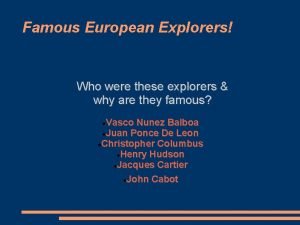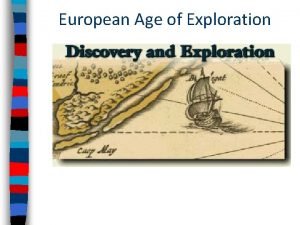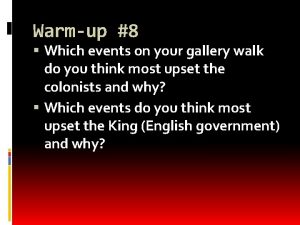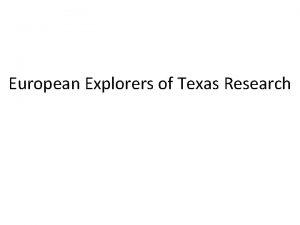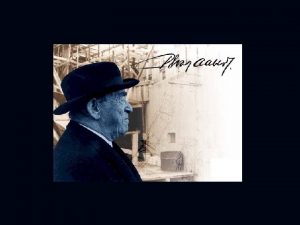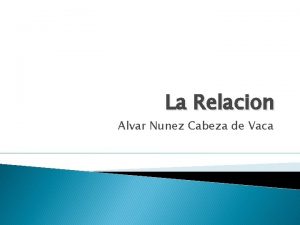European Explorers of Texas Gallery Walk Alvar Nunez









- Slides: 9

European Explorers of Texas Gallery Walk

Alvar Nunez Cabeza de Vaca

Alvar Nunez Cabeza de Vaca

Estevanico (Steven) Estevanico (pronounced es-tay-vahn-EE-co), also called Estevan, Esteban, (1500? -1539) was a Muslim slave from northern Africa (Azamor, Morocco) who was one of the early explorers of the Southwestern United States. Estevanico was the slave of Andrés Dorantes de Carranza, who took him on the Narváez expedition to Tampa Bay, Florida, in 1528. A series of hurricanes and fights with Native Americans killed many of the crew, and the pilot of the ship sailed to Mexico abandoning the men. The 250 to 300 stranded men hastily made 5 makeshift rafts on which they sailed west, hoping to reach a Spanish settlement in Mexico. Three rafts sank, but the two surviving rafts (carrying 80 men) landed at Galveston Island (off what is now Texas). Narvaez did not survive.

Estevanico (Steven) After a very cold winter with very little food, only 15 men survived. In spring, the men traveled west by land, walking along the Rio Grande. By 1533, there were only four survivors, including Estevanico, Carranza, Cabeza de Vaca, and Alonso Castillo Maldonado. The men were enslaved by some Indian tribes along the way, and were helped by other tribes. They were the first non-natives to travel in this area of the southwestern North America. The four men finally reached the Spanish settlement of Culiacan in early 1536 (8 years after being stranded in Florida). Later that year they reached Mexico City, where they were welcomed by the Viceroy Antonio de Mendoza. Carranza then sold Estevanico to the Viceroy. The Viceroy sent Estevanico on an expedition in 1539 with the Franciscan Fray Marcos de Niza. Francisco de Coronado outfitted Estevanico for this trip to find the fabled seven cities of Cibola. On this trip, Estevanico was killed by Zuni Indians as he entered their pueblo (supposedly at the fabled city of Cíbola).

Alonso Alvarez de Pineda was a Spanish explorer and map-maker. Pineda sailed for the Spanish Governor of Jamaica, Francisco de Garay, who sent him to explore and chart the Gulf Coast from Florida to Mexico in 1519. Captain De Pineda and his crew were probably the first Europeans in Texas, claiming it for Spain. One of the regions he explored and mapped was the area around Corpus Christi Bay; De Pineda entered Corpus Christi Bay on the feast day of Corpus Christi, hence the name. The Río de las Palmas has often been associated with Álvarez de Pineda and the erroneous conclusion drawn that this was the Rio Grande. Actually, the Río de las Palmas was discovered by Garay in 1523, when he sailed for the Pánuco to renew Álvarez's settlement and was carried off course by contrary wind and current. Numerous maps and documents spanning the colonial period show that the river called Las Palmas in colonial times was the Soto la Marina, in Mexico. Nothing but supposition connects either Álvarez de Pineda or the Río de las Palmas to the Rio Grande.

Francisco Vasquez de Coronado Francisco Vásquez de Coronado (1510 -1554) was a Spanish ruler, explorer and conquistador. He was the first European to explore North America's Southwest. Coronado was a governor of New Galicia, a western province of Mexico. He searched fruitlessly for treasure that was rumored to exist in northern Mexico: the fabled seven Golden Cities of Cibola. With a group of hundreds of Spaniards and enslaved natives, he traveled through what is now northern Mexico and the southwestern USA (including Arizona, New Mexico, Texas, Oklahoma, and Kansas). His expedition found only Zuñi, Hopi, and Pueblos, native Americans who repelled Coronado when he demanded that they convert to Christianity. Coronado killed many native Americans during this expedition. Since he did not find gold, silver, or other treasures, his expedition was branded a failure by Spanish leaders.

Rene Robert Cavelier Sieur de La Salle La. Salle, a Frenchman, was an early explorer in Texas. He landed in Matagorda Bay (near Victoria which is southwest of Houston) in 1685 by mistake, looking for the mouth of the Mississippi River. When he realized this he knew he had to try and find the Mississippi. First he had to build a small wooden fort, called Fort Saint Louis, for protection from the Indians. During one of his explorations to the east, he had anchored La Belle and gone ashore. A bad storm broke the ship loose and blew it across the bay where it sunk in about 18 feet of water. La. Salle had already had lost of bad luck. He had left France with four ships, one had been sunk by pirates, one sunk trying to come into the Bay, one had gone back to France and now the last one was lost. Three hundred years later, archeologists found La. Belle, covered in mud and muck in the bay. In order to investigate it, archaeologist Dr. Jim Bruseth and a crew from the Texas Historical Commission built a wall around the ship and pumped out the water. Can you believe that? They drove steel beams into the water in Matagorda Bay to create a "room" for the ship and then pumped out the water so they could have an archaeological excavation and recover the ship.

Rene Robert Cavelier Sieur de La Salle A Sad Ending I also found out that they have the actual diary kept by one of La Salles's men, Henri Joutel. That is why we know so much about what actually happened during this expedition. In 1687, after the La Belle sunk, La Salle (his full name is Robert Cavelier, Sieur de La Salle) and 17 men (Joutel was one of these) decided to walk to the northeast to find the Mississippi and follow it back to an area where they knew they would find French settlers. Just think about starting out, afraid of Indians, and planning on walking thousands of miles not really knowing where you are going. Explorers had to be brave. When they left France there were 300 colonists coming to America. Now there were less than 40 left. The ending is really sad. La Salle never made it back to civilization. He was killed by his men before he got to the Mississippi. People think it was in East Texas somewhere. The ones that stayed behind at the fort (about 20 women and children and the sick) were either killed by the Indians or taken to live with them. Only 5 people including Joutel finally reached the French settlement in Canada.
